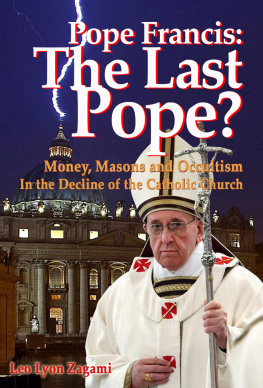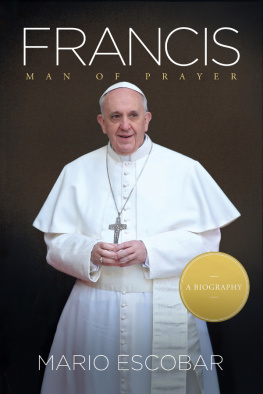Contents
Prologue: The Journey
From the Editor
I t gives me great pleasure to introduce a new platform for The Wall Street Journal s peerless journalism: e-books, published in conjunction with our sister company, HarperCollins.
Our first such venture tells the remarkable story of the ascent of the new head of the Catholic Church. Pope Francis represents the quality, depth, timeliness and resources that readers have come to expect of the Journal , told in the objective narrative style that characterizes our most ambitious work. A rich and in-depth look at Cardinal Jorge Mario Bergoglio, a man little known to much of the world until just a few weeks ago, here is a truly collaborative effort between some of our top reporters and editors around the world, who brought their extensive experience to the project.
In Rome, correspondent Stacy Meichtry and Italy bureau chief Alessandra Galloni tapped their deep sources inside the Vatican to document the challenges facing this two-millennia-old church, and the events that led to the dramatic selection of the first-ever New World pope. In Argentina, reporters John Lyons, Matt Moffett, Jos de Crdoba and Loretta Chao, working with Latin America chief David Luhnow, tracked down friends, colleagues, critics and observers of the new pope in an effort to understand and explain Franciss life, career and perspective.
Pope Francis inaugurates a new way for us to bring you Journal journalism, with greater depth than the daily newspaper allows. Were very excited at the chance to bring this book to you, and we look forward to more in the future. Wed also like to hear from all of you on how weve done and what youd like to see us tackle in the future.
Thank you for reading Pope Francis and The Wall Street Journal .
Yours,
Gerard Baker
Editor in Chief
O n February 27, a mild, dewy morning, an Alitalia flight landed at Leonardo da Vinci airport in Rome after 13 hours in the air. A balding man with gray-white wisps of thin hair stepped out of coach class. He wore thick-rimmed brown glasses and black orthopedic shoes, and moved with a slight limp. His belly looked a bit swollen due to decades of cortisone treatments to help him breathe after losing part of a lung as a young man. Fellow travelers might not even have known that he was a priest, perceiving instead simply a seventy-something gentleman stiff from his travels. No one could see the silver pectoral cross beneath his coat, a token of his authority.
Back home in Buenos Aires, Argentina, Cardinal Jorge Mario Bergoglio cut a prominent profile as the most senior Catholic prelate in his country and a figure known particularly for his work in the citys extensive slums. Here, however, he was one of 115 cardinals converging on Vatican City for important business: the election of a new leader for the Catholic Church. Two weeks earlier, Pope Benedict XVI had suddenly resigned from office, becoming the first pontiff in 600 years to renounce a job traditionally held until death. In church teaching, the position had been handed down for two millennia, starting when Jesus said to St. Peter, On this rock I will build my Church.
Cardinal Bergoglio expected his trip to be brief. He already carried in his black leather briefcase the airplane ticket that would return him home in time for Holy Week, the most important week of the year for a Catholic prelate. His Easter Sunday homily was already written, too, and in the hands of parishioners back home.
Now 76 years old, Cardinal Bergoglio seemed unlikely himself to ascend to the papacy, the top seat of the Catholic Church. He had attracted some support from his brothers in their last conclave, in 2005, the one that elected the then-Cardinal Joseph Ratzinger of Germany to the papacy. But he was eight years older now. And the churchs many serious problemsa sexual-abuse scandal exposing it to disgrace around the globe; a secular tide draining it of members in Europe, the cradle of Christianity; the bitter infighting poisoning the air of the Vatican itselfhad only deepened. Given this climate, many Vatican watchers expected a younger man to ascend, or one with a more-towering profile or sweeping rsum.
Exactly two weeks later, on the evening of March 13, thousands of Romans and visitors from around the world packed the square below the balcony of St. Peters Basilica. In keeping with tradition, white smoke had puffed from the chimney of the Sistine Chapel a short time earlier, signifying that a new pope had been elected. The cardinals had needed only 24 hours to select their leader. The crowd formed quickly, despite rain. People buzzed with anticipation, awaiting the identity of the new Bishop of Rome.
At 8:22 p.m., stepping between the cascading, crimson curtains of the basilicas balcony window, Father Bergoglio emerged.
He had taken the name Pope Francis, it was announced, the first pontiff to do so, after the medieval saint from Assisi who had abandoned his prosperous life to live in poverty and serve the poor. You know that the duty of the conclave was to give Rome a bishop, the Argentine priest said in Italian, in his first words to the crowd. It seems that my brother cardinals went almost to the end of the earth to get him.

T he election of Pope Francis stands as a milestone in the history of the Catholic Church. For most of its 2,000 years, Catholicism spread its influence much like the Roman Empire that came before it, from the core to the periphery. Now, for the first time in the modern era, the leadership of the worlds 1.2 billion Catholics is in the hands of a man from the colonies, someone whose job isin the words of God to St. Francisto rebuild my Church. The Conquistadores brought Catholicism to Latin America from Europe; now that continent claims more Catholics than any region in the world. Francis is the first-ever pope from the Society of Jesus, the Jesuits, a military-inspired company of priests several centuries old that takes as its mission evangelization at the front lines of Christianity.
The new pope forged his ethos at the bottom of the pyramid of life and faith, in the slums of Argentina, where entering a Catholic parish is often as much about getting a warm meal and sanctuary from drug dealers as it is about prayer and reflection. He lived, and worked, in an unstable nation of political extremes whose leadership veered from murderous, right-wing generals to assertive and controversial populist leftists. In a country where the church has often been drawn into politics, he focused on bold gestureswashing the feet of convicts, donning ponchos to blend in with crowds, baptizing children of unmarried parentsand his constant pastoral admonition to get out from behind his desk and take the gospel to the people. A story he likes to tell goes like this: In the Parable of the Lost Sheep, one shepherd leaves his 99 sheep to find the one lost one. In his version of the tale, the church has only one sheep in the pen, but it wont go out for the 99 lost ones.
His lifetime in Argentinaits people shaped by a pioneer mentality, political upheaval and skepticism toward authority bred of bloody military rulehas molded Pope Francis into a man deeply devoted to the church, but leery of its institutional power. Over the years he has at times shown disregard for directives disbursed from a distant Vatican City. His move to the head of the church will present a fascinating test of its centuries-old bureaucracy.
Yet for all the breaks from the past that Pope Francis embodies, he is conservative on church doctrine in many ways similar to his predecessor. He strongly holds that the way to triumph over secularism is to stand defiantly against it rather than to let it influence church teachings. He is unlikely to bend the churchs opposition to abortion or gay marriage. During his time as archbishop, he made a point of meeting with virtually anyone who sought an audience. But he did not meet with alleged victims of sexual abuse by priests.













